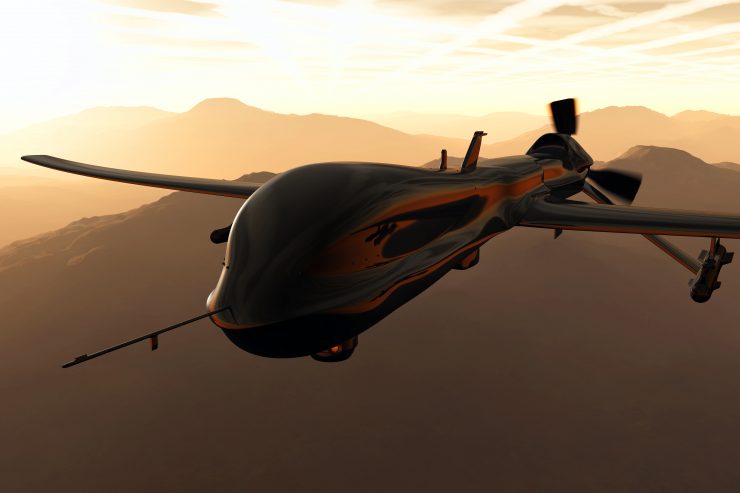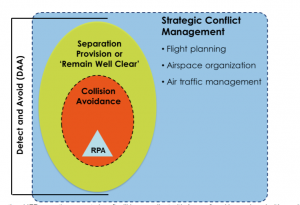The ICAO Remotely Piloted Aircraft Systems Panel (RPASP) has created a draft update of ICAO Document 10019, Manual on Remotely Piloted Aircraft Systems (RPAS). The deadline for comments is 28 February 2021. Among the text is a chapter on “Integration of RPAS operations into ATM and ATM procedures”.
This describes the requirements that RPAS operators will need take into account when planning international flight operations requiring compatibility with air traffic management systems, especially the requirement that detect and avoid systems will need.to be able to detect cooperative and non-cooperative traffic. According to the draft text:
“A DAA system provides two functions, a Collision Avoidance function and a Remain-Well-Clear function. These functions are provided against both cooperative and non-cooperative aircraft by utilizing surveillance, either on board the RPA or on the ground… In International IFR operations, most aircraft will be compliant with Annex 6 and be equipped with an altitude reporting transponder (i.e. cooperative), However, there may also be aircraft, which either legally, illegally, or accidently do not have an operative transponder (i.e. non-cooperative) and the DAA system must detect and track those aircraft as well.”
Excerpt from the chapter:
“Integration of RPAS operations into ATM and ATM procedures”3.1.1 RPAS engaged in operations under instrument flight rules and compliant with ICAO SARPs will participate in the air traffic management system by following existing and new procedures in order to maintain the high levels of safety and efficiency of today’s airspace operations. 3.1.2 An RPAS will meet the communication, navigation, and surveillance equipment and performance requirements for the airspace it intends to operate in and associated with the procedure it intends to utilize. Note: Due to the distributed architecture of an RPAS, alternative means of compliance will be available to meet existing CNS/ATM performance requirements while maintaining interoperability, compatibility, safety, security, and efficiency. 3.1.3 The introduction of an RPA into a given airspace or a particular procedure will not impact Air Traffic Control voice communication performance any more than the addition of an aircraft with a pilot on board. 3.1.4 In airspace where RCP, RNP, and/or RSP requirements are defined, RPAS will be required to meet those requirements. 3.1.5 When ATC communications are relayed via the RPA, means of establishing an alternative means of communication with ATC must be considered in order to mitigate any failure of the RPA relay function. Note 1: Where connections to ATC are discussed, the ATC “system” is assumed to include any already approved communications service providers as appropriate. Note 2.– Establishing an alternative means of communication may include, among others, mobile cell phones, landlines, satellite phones, or CPDLC. 3.1.6 When new ATM procedures are created to enable unique RPA operations or to optimize the efficiency of RPA contingencies (e.g. Lost C2 Link procedures at aerodromes), existing terrain, obstacle, and airspace clearance criteria will remain applicable. 3.1.7 Updates to PANS-ATM will provide addition guidance. DETECT AND AVOID CAPABILITY Rationale: The first edition of the RPAS manual described many different types of UAS and RPAS operations, but the RPASP has narrowed the scope of ICAO SARPs, for now, to International IFR operations, so this edition of the manual focuses on those operations. This should serve to orient the reader and provide context to Chapter 3. Rationale: Current RPAS Manual section 10.1.1 3-2 Manual on Remotely Piloted Aircraft Systems (RPAS) 3.2.1 DAA is defined in Annex 2 as “the capability to see, sense or detect conflicting traffic or other hazards and take the appropriate action”. This capability aims to ensure the safe execution of an RPA flight and to enable full integration in all airspace classes with all airspace users. 3.2.2 While international RPA operations are generally considered to be conducted beyond visual line of sight, there may be portions of a flight (take-off and landing phase) that could be conducted in visual line of sight. In these instances, the requirement to detect and avoid other aircraft may best be accomplished through the use of ground observers or by the remote pilot. 3.2.3 RPA may encounter many types of hazards. The Global Air Traffic Management Operational Concept (Doc 9854) identifies the need to limit the risk of collision to an acceptable level between an aircraft and the following hazards: “other aircraft, terrain, weather, wake turbulence, incompatible airspace activity and, when the aircraft is on the ground, surface vehicles and other obstructions on the apron and manoeuvring area”. Doc 9854 also notes “for any hazard (i.e. any condition, event or circumstance that could induce an accident), a risk can be identified as the combination of the overall probability or frequency of occurrence of a harmful effect induced by the hazard, and the severity of that effect.” Note. – Within the context of the Global Air Traffic Management Operational Concept (Doc. 9854), particularly §2.7.8, DAA fulfils the Collision Avoidance layer of conflict management and, when appropriate, fulfils the Separation Provision layer of conflict management. 3.2.4 A DAA system provides two functions, a Collision Avoidance function and a Remain-Well-Clear function. These functions are provided against both cooperative and non-cooperative aircraft by utilizing surveillance, either on board the RPA or on the ground.
Note: In International IFR operations, most aircraft will be compliant with Annex 6 and be equipped with an altitude reporting transponder (i.e. cooperative). However, there may also be aircraft, which either legally, illegally, or accidently do not have an operative transponder (i.e. non-cooperative) and the DAA system must detect and track those aircraft as well. Rationale: Current RPAS Manual section 10.2.1. Note is from a draft version of Annex 10 Vol IV Part 2 developed by RPASP/WG3 and here helps to tie together the reference to DOC 9854. 3.2.5 Annex 10 V risk mitigation capability for IFR flight in controlled airspace and aerodromes. Other hazards are documented in the ICAO Global Air Traffic Management Operational Concept (Doc 9854). These hazards may be addressed through the use of existing aircraft systems (e.g. weather radar, TAWS, etc.) or through operational limitations on the flight route. Note: The first edition of Annex 10, Volume IV, Part 2 emphasizes DAA for conflicting traffic that requires a dedicated Future editions of Annex 10, Volume IV, Part 2 may address SARPs for hazard management equipment that is unique to RPAS. |
(Image: Shutterstock)





